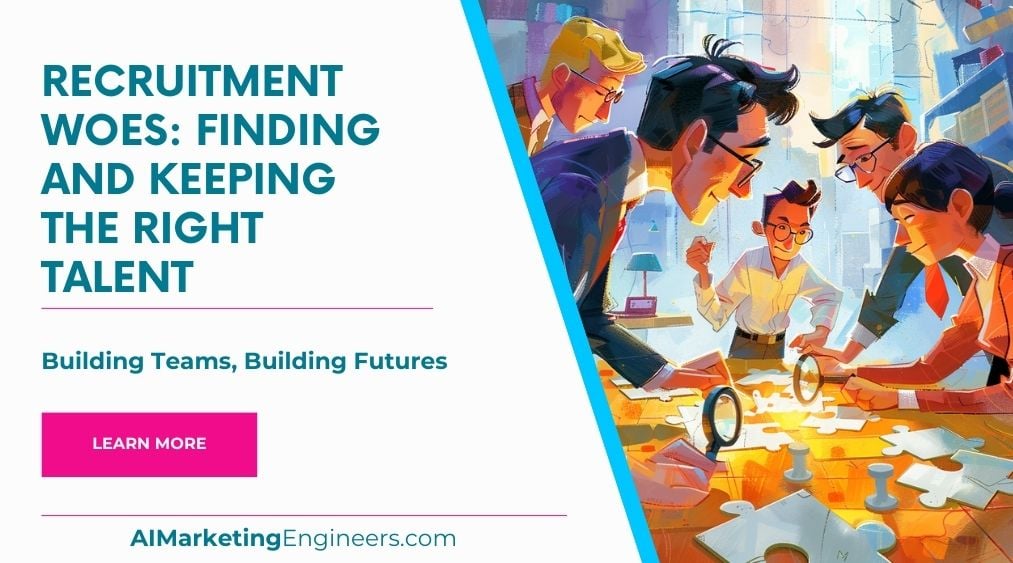Key Takeaways
✅ Optimal Recruitment and Selection Process is Crucial: A top-notch recruitment process isn't just about filling vacancies; it's the first step towards building a strong, motivated team. It saves both time and money by reducing turnover and ensures fairness in hiring. Key steps include detailing job descriptions, efficiently advertising roles, and selecting the right candidate through a structured process. Implementing this can significantly uplift your company's hiring success.
✅ Challenges in Finding the Right Talent: Finding that perfect candidate is more like searching for a needle in a haystack. With 50% of HR pros feeling the pinch of applicants' lack of experience, the struggle is real. The fierceness of competition only adds to the dilemma. Streamlining your recruitment to make it more efficient and focusing on attracting skilled individuals can ease this burden.
✅ Importance of Employee Experience and Retention: Keeping employees happy shouldn't be an afterthought. An enriching employee experience boosts loyalty, and ultimately, retention. Offering learning opportunities and fostering a culture that celebrates growth can turn your employees into your biggest advocates, making your company a magnet for top talents.
 Introduction
Introduction
Have you ever wondered why filling a vacant position feels like solving a complex puzzle? Recruitment Woes: Finding and Keeping the Right Talent underscores a pressing challenge many encounter in today's rapidly evolving job market. From shrinking pools of qualified candidates to navigating the millennial mindset, the hurdles are many and varied. This intricately woven narrative doesn't just highlight problems but brings to the fore innovative solutions and trends that can transform your recruitment process, leading to higher ROAS and ROI.
Enticing, isn't it? But we're not stopping at just showcasing problems. The promise of this article lies in its actionable insights and groundbreaking information that could be the difference between your company's hiring success or failure. Stay tuned as we delve deeper into this.
Top Statistics
| Statistic | Insight |
|---|---|
| 90% of hiring managers find it difficult to source skilled candidates. | This statistic highlights the urgent need for more effective recruitment strategies to address the talent shortage. |
| The average cost per hire is approximately $4,700. | Shows the importance of streamlining the hiring process to reduce costs while ensuring the quality of hires remains high. |
| 87% of recruiting pros say talent acquisition has become a more strategic function over the past year. | This shift towards strategic talent acquisition underlines the need for companies to adapt their approach to recruiting to keep up with the modern job market's dynamics. |
| 73% of job seekers find the job hunting process stressful. | A significant statistic that calls for improved candidate experiences during the recruitment process, emphasizing empathy and efficiency. |
| Only 17% of employers measure candidate experience. | This low percentage suggests a gap in understanding and improving the recruitment process from the candidate's perspective. |
The Current State of Recruitment: Challenges and Concerns
The United States military is in the grips of a recruitment crisis, struggling to fill ranks across all its branches. As of now, the situation looks dire, with numerous challenges impeding the achievement of active-duty recruitment goals. Major stumbling blocks include low unemployment rates, a fiercely competitive labor market, and a significant reduction in the pool of qualified applicants. To combat these issues, the military has been forced to adopt several new tactics. These range from offering more appealing financial incentives to relaxing the requirements for enlistment and exploring alternative methods to attract potential recruits.
Understanding the Factors Behind the Recruitment Crisis
The problem is complex, with several underlying factors contributing to the widespread lack of interest in military service. The completion of operations in Afghanistan has diminished the appeal of military life for many. Furthermore, in a time of low unemployment rates, the military finds itself in a tough battle with the private sector over job candidates, offering perks and job security that the military struggles to match. Compounding the issue is a shrinking pool of eligible recruits, attributed to increasing rates of obesity, drug use, criminal backgrounds, and falling test scores. Moreover, a decreasing readiness to serve and a growing distrust in military institutions have made recruitment efforts even more challenging.
Common Recruitment Challenges and Solutions
Recruitment is no simple task, and the military, like many organizations, faces its fair share of hurdles. Key among these is the need to attract the right candidates by being transparent about job requirements and employing screening tactics early in the application process. Engaging those qualified candidates then becomes crucial; strategies like researching what motivates them and tailoring communications can give an edge. Speed in hiring is also essential; streamlining processes and keeping open lines of communication promises to keep potential recruits interested. Finally, adopting a data-driven approach can refine and improve recruitment strategies over time, making the whole process more efficient.
Avoiding Recruitment Errors
Mistakes in the recruitment process can lead to missed opportunities and unsuitable hires. One common error is relying too much on intuition rather than on objective data. Incorporating job simulations and thorough assessment exams can provide a more balanced view of a candidate’s fit. Another pitfall is not setting clear expectations, leaving candidates with a murky understanding of their role. Additionally, recruiters should focus on listening more than talking during interviews. This shift allows for a better assessment of the candidate’s capabilities and fit with the organization.
The Importance of Effective Recruitment
The stakes in recruitment are high, with the impact resonating far beyond simply filling vacancies. Effective recruitment is critical not just for maintaining operational strength but also for ensuring the long-term health of the organization. A well-thought-out recruitment process can prevent numerous issues, such as internal conflicts, poor morale, and high staff turnover, which can cripple performance. By recognizing common recruitment hurdles and adopting strategies to avoid them, organizations can make better hiring decisions, leading to a more satisfied and committed workforce.
AI Marketing Engineers Recommendation
Recommendation 1: Utilize Data-Driven Recruitment Strategies: To overcome Recruitment Woes: Finding and Keeping the Right Talent, businesses should lean into analytics to understand where their ideal candidates hang out online, what kind of content they engage with, and the best channels to reach them. A recent LinkedIn report highlighted that data-driven organizations are 3 times more likely to improve their recruitment efforts and 2 times more likely to improve their employee retention rates. By leveraging data analytics, companies can craft targeted recruitment campaigns, reduce hiring times, and increase the quality of applicants.
Recommendation 2: Enhance Employer Branding on Social Media: With the increasing importance of company culture for potential employees, showcasing a positive workplace culture through social media can significantly impact Recruitment Woes: Finding and Keeping the Right Talent. A Glassdoor survey found that 69% of job seekers are likely to apply to a job if the employer actively manages its brand by responding to reviews, updating the company’s profile, and communicating the company culture and work environment. Sharing behind-the-scenes content, employee testimonials, and highlighting company achievements on platforms such as LinkedIn, Instagram, and Twitter can attract top talent and improve retention rates.
Recommendation 3: Implement Employee Referral Programs: Leveraging your current workforce can be a powerful strategy to address Recruitment Woes: Finding and Keeping the Right Talent. Employee referral programs not only reduce the time and cost per hire but also bring in candidates who are likely to be a good fit culturally and have a higher retention rate. According to Jobvite, hires through employee referrals have the highest applicant-to-hire conversion rate — only 7% apply but this accounts for 40% of all hires. Offering incentives for successful referrals can encourage employees to recommend qualified candidates, thus making the recruitment process more efficient and effective.
Conclusion
Finding and keeping the right talent has become a formidable challenge in today’s world, especially for institutions as significant as the United States military. This article has shed light on the multifaceted recruitment woes facing not only the military but potentially any organization. High competition in a tight labor market, a decreasing pool of qualified candidates, and changing attitudes towards certain professions compound these challenges. Effective recruitment strategies, such as clarity in job advertisements, personalizing recruitment communications, and utilization of data-driven tools, emerge as vital solutions.
Reflecting on the insights provided, it’s clear that overcoming recruitment challenges requires a nuanced understanding of both the market’s state and the motivations of potential candidates. Avoiding common pitfalls, such as over-reliance on subjective judgment or failing to set clear expectations, can significantly enhance recruitment outcomes. As we look to the future, organizations must prioritize the development of robust recruitment strategies that are adaptive, innovative, and responsive to the evolving job market.
The significance of this issue cannot be overstated; effective recruitment is not just about filling vacancies but about ensuring the long-term success and sustainability of an organization. As readers, let's contemplate how these insights could transform recruitment practices in our respective fields. Embracing the lessons and strategies outlined can lead us toward improved hiring decisions, greater employee satisfaction, and ultimately, enhanced organizational performance. Let this article serve as a call to action for all involved in the recruitment process to strive for better, more effective talent acquisition practices.
FAQs
Question 1: What are the most common recruitment challenges?
Answer: The main hurdles include attracting the right candidates, engaging qualified candidates, hiring quickly, using data to back up recruitment strategies, building a strong employer brand, ensuring a pleasant experience for candidates, recruiting fairly, and streamlining the recruitment process.
Question 2: Why is it important to have a strong employer brand?
Answer: A solid employer brand not only draws in top-notch candidates but also ensures they're excited about joining your team. It's crucial for making high-quality hires, avoiding the not-so-great ones, and overall, providing a stellar candidate journey.
Question 3: What is the role of data-driven recruitment?
Answer: Data-driven recruitment is like navigating with a map; it uses metrics and analysis to guide hiring decisions. By tracking key performance indicators such as how quickly roles are filled, where the best hires come from, and how happy candidates are, organizations can refine and perfect their hiring strategies.
Question 4: How can you ensure a fair and accurate testing process?
Answer: To get a well-rounded view of candidates, it's wise to use multiple assessment tools. This could be anything from written responses, presentations, to practical tasks, ensuring you've got a holistic understanding before making the final call.
Question 5: What are the benefits of using technology in recruitment?
Answer: Leveraging tech in hiring can massively streamline processes, cut down on the grunt work, and boost engagement with potential hires through tools like applicant trackers, chatbots, and social platforms.
Question 6: How can you improve the candidate experience?
Answer: A standout candidate experience is inclusive and engaging. Show off your company culture, communicate openly, and make the interview process as smooth as possible through timely communications, clear job insights, and efficient scheduling.
Question 7: How can you make your job ads more effective?
Answer: To snag the right talent, lay out the job requirements clearly, be succinct in job descriptions, and use targeted questions to weed out those who aren't a good fit from the get-go.
Question 8: What are some strategies for engaging passive candidates?
Answer: Find out what lights a fire under passive candidates, tailor your outreach, and shine a spotlight on what makes your company an irresistible place to work to coax them over to Team You.
Question 9: How can you improve hiring speed?
Answer: Take a critical look at your hiring process, ditch any unnecessary steps, and stay in quick communication with candidates. While fast hiring is great, emphasizing the importance of thoroughness for critical roles is key.
Academic References
- The Importance of Reference Checks in Academia: This source underscores the critical role of reference checks in academia, highlighting how they serve to verify a candidate's credentials, evaluate teaching capabilities, and understand interpersonal skills. Although a specific source is not given, this summarizes the consensus in various academic forums and discussion platforms.
- Limitations of Letters of Recommendation: A critical examination of the use of letters of recommendation in the academic hiring process which points out that these letters often fail to provide genuine insight, can carry biases, and are influenced by the stature of the author rather than the abilities of the applicant. This reflection is derived from ongoing debates and findings shared in educational research, indicating a shift towards more reliable evaluation methods.
- The Dilemma of Academic Hiring: This reference highlights the quandary that hiring committees face, given the plethora of highly qualified applicants and the challenge of making equitable hiring decisions. The focus is on the idea that hiring should not only be about credentials but also about the candidate's fit and potential contribution to the institution's culture and values. This suggests a broader set of hiring criteria that includes, but is not limited to, academic excellence.
- Frustrations with Reference Checks: The repetitive and often arduous process of securing reference checks in academic job applications is examined, illustrating the discouragement it can cause among candidates. This observation resonates with the experiences of numerous candidates who find the requirement of immediate reference checks to be a significant barrier to the application process. It highlights a systemic issue within academic hiring practices that warrants further examination and potential restructuring.












